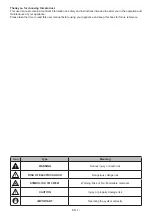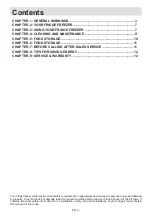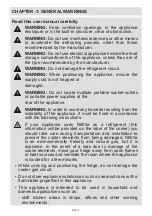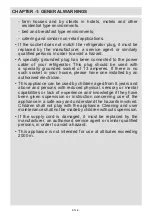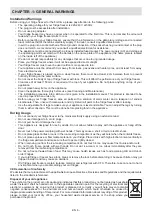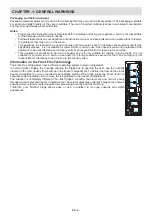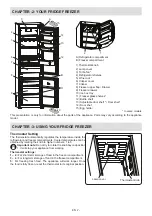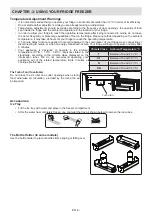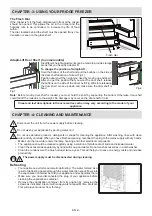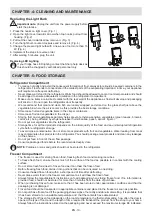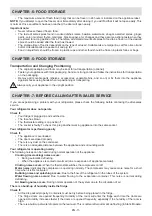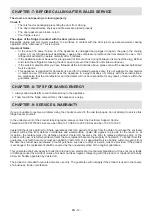
EN -11-
CHAPTER -5: FOOD STORAGE
• The maximum amount of fresh food (in kg) that can be frozen in 24 hours is indicated on the appliance label.
NOTE:
If you attempt to open the freezer door immediately after closing it, you will find that it will not open easily. This
is normal. Once equilibrium has been reached, the door will open easily.
Important note:
• Never refreeze thawed frozen food.
• The taste of some spices found in cooked dishes (anise, basilica, watercress, vinegar, assorted spices, ginger,
garlic, onion, mustard, thyme, marjoram, black pepper, etc.) changes and they assume a strong taste when they
are stored for a long period of time. Therefore, add small amounts of spices to food to be frozen, or the desired
spice should be added after the food has thawed.
• The storage time of food is dependent on the type of oil used. Suitable oils are margarine, calf fat, olive oil and
butter. Unsuitable oils are peanut oil and pig fat.
• Food in liquid form should be frozen in plastic cups and other food should be frozen in plastic folios or bags.
CHAPTER -5: FOOD STORAGE
Transportation and Changing Positioning
• The original packaging and foam may be kept for re-transportation (optional).
• Fasten your appliance with thick packaging, bands or strong cords and follow the instructions for transportation
on the packaging.
• Remove all movable parts (shelves, accessories, vegetable bins, and so on) or fix them into the appliance
against shocks using bands when re-positioning or transporting.
Always carry your appliance in the upright position.
CHAPTER -7: BEFORE CALLING AFTER-SALES SERVICE
If you are experiencing a problem with your refrigerator, please check the following before contacing the after-sales
service.
Your refrigerator does not operate
Check if:
• Your fridge is plugged in and switched on
• The fuse has blown
• The thermostat setting is on position '1'
• The socket is faulty. To check this, plug another working appliance into the same socket.
Your refrigerator is performing poorly
Check if:
• The appliance is overloaded
• The doors are closed properly
• There is any dust on the condenser
• There is an adequate distance between the appliance and surrounding walls
Your refrigerator is operating noisily
The following noises can be heard during normal operation of the appliance.
Cracking (ice cracking) noise occurs:
• During automatic defrosting.
• When the appliance is cooled or warmed (due to expansion of appliance material).
Clicking noise occurs:
When the thermostat switches the compressor on/off.
Motor noise:
Indicates the compressor is operating normally. The compressor may cause more noise for a short
time when it is first activated.
Bubbling noise and splashing occurs:
Due to the flow of the refrigerant in the tubes of the system.
Water flowing noise occurs:
Due to water flowing to the evaporation container. This noise is normal during
defrosting.
Air blowing noise occurs:
During normal operation of the system due to the circulation of air.
There is a build-up of humidity inside the fridge
Check if:
• All food is packed properly. Containers must be dry before being placed in the fridge.
• The fridge doors are opened frequently. Humidity of the room will enter the fridge each time the doors are
opened. Humidity increases faster if the doors are opened frequently, especially if the humidity of the room is
high.
• There is a build-up of water droplets on the rear wall. This is normal after automatic defrosting (in Static Models).



